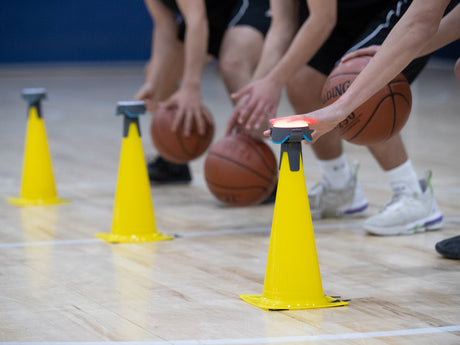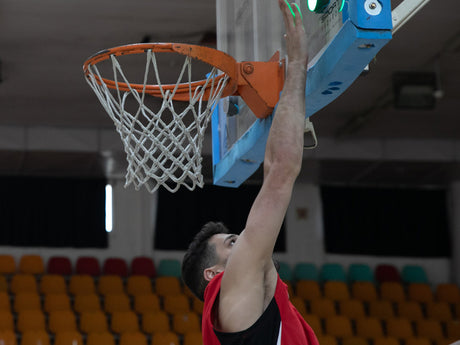There’s no secret formula to being a great basketball player. However, zooming in on the lives of top players in the sport, there’s a lot of basketball training techniques that you can borrow as the coach to improve your team's game.
In this list, we’ve included 13 tactics and strategies for how to train for basketball based on the best basketball players’ training routines. Regardless of your players' level of experience, adding these tips to your basketball training program might accelerate their growth in the sport.
Technical and Tactical Skills of Basketball
1. Encourage Them to Get Some Nice Basketball Shoes
Often we’re asked whether running shoes can be used for playing basketball. Yes- you can play basketball in running shoes, especially if they have a formidable court grip. However, this will depend on the regularity.
If your players are planning to play consistently (daily or several times a week), getting a pair of basketball shoes will be the wisest thing to do. Thanks to the design of these shoes (thick and rigid sole plus a high ankle), the player can confidently make regular stops and starts and change direction at speed without turning their ankle.
You're probably aware that ankle sprains are the most prevalent injuries. While they are often minor, injuries to the lower extremities can easily impede your team's basketball training program.
2. Know Your Players' Strengths and Weaknesses
Each of the players in your basketball team has his/her share of strengths and weaknesses. For instance, some could have excellent basketball defensive strategies; they can steal balls easily and are able to block almost any player. On the flip side, their shooting form may be annoyingly inconsistent, or they may have trouble identifying proper shooting angles.
While no player can’t be good at everything, a glaring weakness that’s easy for your opponents to exploit can greatly impact the team.
So, as you hunt for the best basketball tips and training strategies for your players, take a moment and reflect on what they are good at and what drags them behind.
3. Customize Your Workouts Accordingly
There are tens of basketball exercises that you can add to your team's daily workout routine. But no matter how effective the exercise is thought to be, it won’t make a difference in your players' gameplay if it doesn’t help conquer their weaknesses.
An effective basketball court training should work on their weaker areas while perfecting their strengths. If a player is already good at setting screens or making 3-point shots but has a problem with court speed, then you want to major in exercises that help them improve their athleticism. So after making a list of their strengths and weaknesses, identify effective basketball drills that best suits what you want them to improve on.
4. Have a Clear Workout Plan
After identifying drills and exercises that will improve your team's play, the next step is to develop a strategy on how you’ll meet your goals. It’s a good coaching habit to have a goal on what you want the players to accomplish during each workout session in the gym. Otherwise, you’ll find the players spending the most time on what they enjoy doing most while having little to no time for areas that seem challenging. This calls for an actual plan recorded, be it on a notebook or your phone.
Benefits of Having a Workout Plan for Your Team's Basketball Training
Having a basketball training plan adds the following benefits to your workout regimen;
- Promotes effectiveness and timeliness. The players stop after completing the drills, not because they're tired.
- Ensures that the workouts are balanced on your players' strengths and weaknesses.
- It Makes it easy to keep a record of the workouts. This is necessary to avoid over-training.
- It ensures that you work towards a goal.
- Promotes variations in your workouts to minimize boredom.
5. Practice Outside Practice
Great players understand that it takes a tremendous amount of time and energy to get really good in this sport. That’s why most NBA players spend tons of extra hours exercising alone outside of team training. Pistol “Pete” Maravich- one of the best shooters in college basketball and a Hall of Famer- used to practice an average of 4 hours out of practice every day.
It might be improbable for most of your players to dedicate so many hours outside of practice every day- a well-balanced life is crucial after all. All in all, encourage them to find some time and exercise on their own either in the backyard or empty court. Sometimes players are able to push themselves more without the fear of making mistakes when they are alone.
6. Motivate Them to Make One Great Shot… 1500 Times Every Week!
All basketball players need to know how to make great shots regardless of their position in the game. Being a good shooter not only makes them resourceful players for the team, but it also makes life easier for you when making the playing team during a match.
The best shooters in basketball history, including Stephen Curry, Klay Thompson, Ray Allen, and so on weren’t born sharpshooters. They began like everyone else and developed their shooting ability over the years.
You’ve probably heard that to perfect their shooting skills, your players need to make at least 1500 shots every week. Great shooters don’t just make 1500 shots: they repeat one great shot 1500 times every week.
A good way to start is by helping your players perfect your shooting form. They should be able to make a praise-worthy shot from anywhere on the court. So as they make their 1500 weekly shots, motivate them to simulate different game conditions and situations, for instance, running off a screen, fading away, and dribble pull-ups if you want to carve them into all-round shooters.
7. Consistency is Key
Consistency should be one of your basketball training rules if you want your team to get good at any suggested game strategy for basketball. Meeting their weekly basketball shots target is great. However, if they won’t show up again for the training until after two weeks, this will add very little value to their skills.
A player becomes the best in a certain area, for instance, dribbling, shooting, or passing, because they have developed those strategies into their muscle memory. In sports, muscle memory is developed through repetitions- not in a single day. Although practicing a particular move for 4 hours a day might pay off, you’ll see faster results if they train for 1-2 hours daily for 4 days.
While consistency is important, remind them that perfection is vital. If they continue repeating the wrong move consistently, they will only be developing bad habits, which will be translated into their game-time baskets. As they inscribe a skill into their muscle memory, encourage them to ensure that it’s the correct move.
8. Perfect Your Team's Passing Techniques
Your team’s success during a basketball match lies in the ability of all players to funnel their individual accomplishments and abilities toward the team’s objectives. This is a team game. Regardless of one player's shooting and dribbling abilities, it’s impossible to win the match alone. That’s why excellent passing techniques are a vital component for effective basketball offensive strategies.
When the entire team perfects its passing ability, it will always have the opponent team’s players on their heels. The uncertainty of who will get the ball next can successfully lead to numerous wide-open chances leading to easy layups and 3-pointers.
Also, a team that effectively passes the ball around the court will almost always have a player at a sweet spot to make an uncontested shot.
9. Push Them to Practice at Game Speed
The main objective when working out should be to learn and perfect a particular move and then repeat it in a match. If your players find it difficult to execute a move that they have been perfecting when working out, it’s probably because they haven’t been practicing at game speed.
Game speed in basketball means just that… practicing as one plays. When practicing alone, ask your players to imagine that persistent opponents are guarding them, and they have to weave through them. This will help in mimicking game-like pace, and they will have an easier time come game time.
Practicing at game speed applies to all components of a basketball player, including speed and agility. Assuming that your players are always training at 50% speed, they are very unlikely to explode at 100% speed with the ball during a match.
There are a few exceptions to this principle, though. For instance, a player may not be able to work out at game speed if they have been away from the action due to an injury. But they should be out of the post-injury mental cage soon with regular exercise and hard work.
10. Advise Your Players to Get in Shape
Basketball is a high-intensity game that involves sprinting, jumping, shuffling, and rapid direction changes. These activities demand a lot of energy. Unless they are in great shape, they will often be tiring within the first few minutes of the match. That’s why conditioning needs to be a central part of your basketball coaching tactics.
Conditioning in basketball helps in developing endurance. The latter is necessary to shuffle back and forth the floor and repeat short sprints when training and during a real match. Experts suggest that the first and the last minutes are the most important in a basketball game. The team whose players can remain at the top of their game from the start to the end has higher chances of winning.
11. Ask Them to Understand Their Role and Be Perfect at It
We like to view a basketball team as a machine with different parts that need to work together to achieve a goal. Likewise, each player has a crucial role in the success of the team. Just like each part of a machine is engineered to perform a particular task, each player in the team is gifted differently. A player may not be the fastest on the team, but perhaps he/she is very good at scoring.
As you look for tips for improving your players' skills in basketball, be clear on which of the 5 basketball positions each of the players is best suited for. After understanding the position that they are cut for, the next task is to help them understand the roles and responsibilities required of them. Also, this makes it easy to determine the skills that each player needs to work on.
12. Find a Training Partner
There are different basketball training drills and exercises that your players can perform solo. But there are other times when they will need another person to rebound for them or help them develop and perfect their 1v1 tactics.
Often your players will grow faster if they have a team player who encourages and challenges them to get out of their comfort zone. So ask them to identify a teammate and develop a game plan and a series of basketball drills to develop both parties.
13. Encourage Them to Never Stop Improving
Despite their excellence in the game and impressive tactics, you’ll realize that most of the best basketball players never stop training. That’s why they always surprise us with new moves and tactics each season. This implies that there’s no end to learning in basketball.
Once they have learned and perfected a particular move, motivate them to look out for other strategies from other experienced players and try to replicate them. That’s the mindset that future-oriented basketball players need to have.
If you’re looking for a system that will boost your clients’ basketball training workouts, the Blazepod flash reflex training kit might be what you’re missing. This is an easy-to-use system designed to grow basketball players by boosting their response time, court speed, ball-handling, and efficiency. This innovative light-based comprises durable, weatherproof, and smash-proof Bluetooth-enabled pods and an intuitive App. From the App, you can choose between different exercises (existing or customized) and track and measure your clients’ progress.








